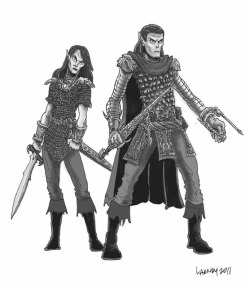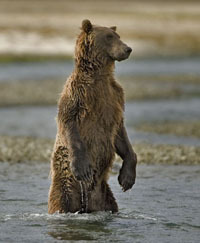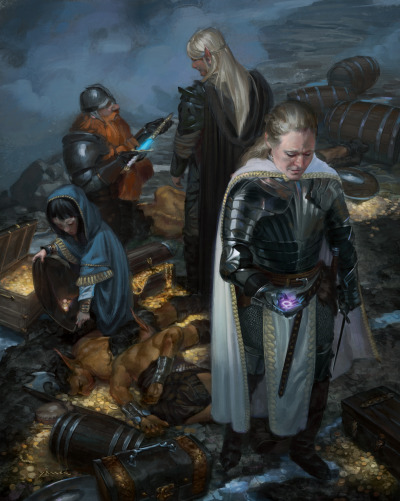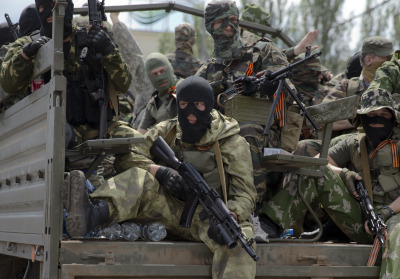Red Elves
 Considering how "regular" elves are described (under the Adventuring in Dwimmermount chapter), I have made the Red Elves even more alien and strange. I took inspiration from Pearce Shea's post and made sure "Something about (Red) Elven biology is transmittable." The Red Elves are the Ancients' greatest experiment made flesh. A magical disease that has found god, or its own idea of god. The disease must be shared, but only with those who are considered worthy. The Thulians proved their worth when they managed to overthrow the Red Elven empire, but the Red Elves won't make any mistakes when they attempt to reclaim their old kingdom. They are coming back to Telluria to turn the Thulians into Red Elves just like themselves, to share their disease.
Considering how "regular" elves are described (under the Adventuring in Dwimmermount chapter), I have made the Red Elves even more alien and strange. I took inspiration from Pearce Shea's post and made sure "Something about (Red) Elven biology is transmittable." The Red Elves are the Ancients' greatest experiment made flesh. A magical disease that has found god, or its own idea of god. The disease must be shared, but only with those who are considered worthy. The Thulians proved their worth when they managed to overthrow the Red Elven empire, but the Red Elves won't make any mistakes when they attempt to reclaim their old kingdom. They are coming back to Telluria to turn the Thulians into Red Elves just like themselves, to share their disease. the Gift
If a Red Elf spits or bleeds into another person's open wound (they lick their weapons when forced to fight somebody they consider worthy of the Gift) they must save vs Constitution (DC 20) or begin turning into a Red Elf. On a failed save, the character now has a Gift score. Roll 1d4 and add this to the character's Gift score, successive failures will add to the Gift score. The Gift is considered a magical disease for purposes of reversing or preventing progression, however once the Gift Score reaches 15+ the disease has done it's job and can no longer be reversed short of a Wish spell.
the Score
1-5 = your skin turns a pale red hue, ears begin to grow pointed, body begins to grow lithe (the changes are quick to appear but are subtle, after 1 Long Rest this change takes full hold and is completely apparent and permanent)
6-9 = you acquire Darkvision (if you didn't already have it) and moonlight will refresh you during a Short Rest removing the need to eat (dehydration is still an issue)
10-14 = all magical forms of reincarnation, regeneration, and resurrection no longer work upon you however you no longer age, are immune to nonmagical disease, and barring injury are effectively immortal
15 = after 1 Long Rest you will fully transform into a Red Elf gaining all of the racial qualities of the new race and losing any racial qualities of your old race (this may include adjusting ability scores appropriately), you are also now considered a 1st-level Sorceror as well in addition to any class you already were (if you were already a Sorceror in some capacity then there is no change, otherwise it acts as an "extra" level)
goblinoids as animals
I've mentioned before that I'm using the old school pig-faced orcs, at least how they were depicted in 1st edition rulebooks. I also didn't like the wererat descriptions, because I didn't think it made much sense that a group of wererats had been locked away into Dwimmermount for 200 years, and so I changed them into ratkin. I changed hobgoblins into rhino-faced men. The other races in Dwimmermount are largely unchanged:
Gnolls will more closely resemble a variety of dogs, and not hyenas
Minotaurs are unchanged
Ranine are unchanged (they look like frogmen)
Thelidu are unchanged (they resemble mind flayers)
Throghrin are peppered throughout the adventure without any good descriptions, I've decided to make them the most alien and scariest looking monsters by making them half-spider, similar to driders though about the same size as halflings
Troglodytes are going to resemble bears that can walk upright



 Houston, Texas. The national government and separatists in the country's south may have agreed to a cease-fire and peace talks six weeks ago, but you wouldn't know that here in the stronghold of the rebellion.
Houston, Texas. The national government and separatists in the country's south may have agreed to a cease-fire and peace talks six weeks ago, but you wouldn't know that here in the stronghold of the rebellion.